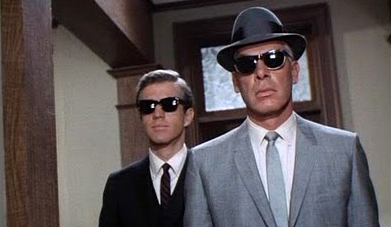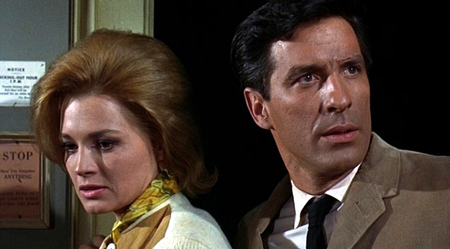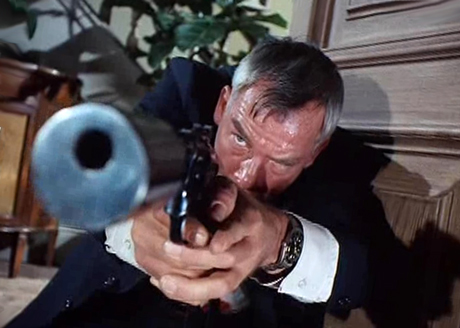Reviewed by Glenn Erickson
Here's a real achievement, a new Blu-ray that makes a feature film look far better than it ever has before, even on a big screen. Eleven years ago the Criterion Collection released an impressive double bill of both film adaptations of Ernest Hemingway's The Killers. The brief short story was successfully expanded to feature length in 1946, with the use of Citizen Kane- like flashbacks to a highly romantic, fateful story of crime and betrayal. The Robert Siodmak movie made stars of Burt Lancaster and Ava Gardner. I've watched the 1964 remake several times, but Arrow Films' new disc is so much of an improvement that it feels like seeing it for the first time.
As a general rule classic films noir resist remake efforts: much of what works about them is endemic to the time they were made. Restage 1945's Detour in the present day and Al Roberts' self-pitying pessimism wouldn't work for a minute. But noir veteran Don Siegel had been a central figure in the evolution of '50s noir, in pictures like Private Hell 36 (1954), Baby Face Nelson (1957) and The Lineup (1958). The romanticism of noir was breaking down in Siegel's films, as the level of cynicism and violence steadily climbed.

Gene L. Coon's nervous screenplay for Siegel's The Killers flips the original storyline like a pancake. The '46 version featured an insurance investigator obsessed with finding out why the target of paid killers didn't make an effort to save himself. Siegel's version has no sleuth tracking down the facts, in fact, almost no cops at all. It instead gives the investigating duties to a pair of chatty Pulp Fiction- like hit men in search of a big payday. Siegel develops the contract killer ethos more than any other director: Robert Keith and Eli Wallach in his The Lineup may be the real original protagonist hit men with quirky personalities.
As opposed to classic noir, The Killers takes place almost completely in broad daylight. The brutal Charlie Strom (Lee Marvin) and Lee (Clu Gulager) trace their contract target Johnny North (John Cassavetes) to a school for the blind, where he teaches an auto shop class. To their surprise, North passively accepts his fate. Intrigued, Charlie and Lee crisscross the country to ferret out North's backstory, both to quench Charlie's curiosity and to profit from whatever crime their victim was a part of. As it turns out, North was a promising race car driver until a debilitating accident that may have been caused by the distraction of his flashy new girlfriend, Sheila Farr (Angie Dickinson). Starting with the testimony of mechanic Earl Sylvester (Claude Akins), Charlie and Lee learn about North's involvement in an armored car robbery, for Sheila and her new boyfriend, crook Jack Browning (Ronald Reagan). If the hit men can find Sheila and Jack, the loot can't be far away.

The Killers rewrites the rules for screen crime. Almost as if the production code no longer existed, "nice" characters are nowhere to be seen, and no authority figures reassure us that law and order is being upheld. The obsessed Charlie and the wisecracking health nut Lee terrorize innocent people for information, just like Hemingway's original Al and Max but with an essential difference of expedience. In the hepped-up, speed-obsessed sixties, Charlie and Lee have no time to mess around. Rudely cornering their prey, they immediately go for the hard sell, whether it means hanging a woman out of a high window or driving a helpless blind lady into hysterics. They carry their pistols in a valise, as if they were businessmen paying a sales call.
Making the film seem even more modern, Charlie and Lee already display the "look" that dominates hit man characters to this day. They wouldn't be caught dead without the heavy dark glasses that make them look ominous, almost faceless. Director Don Siegel nails a prime visual that's become an icon: when Charlie aims his gun, a wide-angle lens frames his oversized silencer in huge close-up. Charlie's on the trigger but the gun is given a greater graphic emphasis. 1

Johnny North's role as an existential loser is basically the same as in the '46 version. John Cassavetes had received a big career boost when he played a twisted juvenile delinquent back in Don Siegel's excellent Crime in the Streets (1956) (which incidentally also seems to have influenced the gang action in the play and movie West Side Story). Here Cassavetes is the cocky driver of a Cobra racing car. His stomping ground is the former Riverside International Raceway, which had already been used for the violent car race action scenes of 1959's On the Beach. One of the hottest actresses of her time, Angie Dickinson is a new brand of amoral thrill-seeker. She's attracted to Johnny when he's a winner but quickly abandons him when he's injured. There's no longer any romantic mystique with this femme fatale, as she immediately goes where the money is. Cassavetes' North is already defeated when he agrees to drive a vehicle in Jack Browning's robbery scheme. This part of the movie seems lifted intact from Richard Quine's 1954 noir Drive a Crooked Road. Just like Mickey Rooney in the earlier picture, North is hired because he can cover a mile or so of twisting country road in less than a minute. Sheila tempts North with a promise of a mutual getaway when the job's done... a sucker play if ever there was one.
It's quite a surprise to see Ronald Reagan playing a humorless crook in the picture, his final feature film before becoming Governor of California. Perhaps the man most hated by U.C.L.A. students in 1970-71, Reagan dispatched an army of cops to teach a lesson to demonstrators against the invasion of Cambodia. The amazing thing about Reagan's performance in The Killers is that he wears the same permanent scowl that he showed in newsreels when he promised to deal out punishment to Berkeley and U.C.L.A.. A one-dimensional heavy with no redeeming qualities, Reagan is as rigid as a washboard. But his Jack Browning has a jaw-dropping moment of violence when he slaps Angie Dickinson across a room. It's a classic piece of film, just on content alone: Burt Bacharach's woman recoils backward, hair flying, and our cool liberal Cassavetes, Machine Gun McCain himself, decks Reagan with a retaliatory right cross. This utterly priceless scene got standing ovations at UCLA; why doesn't it show up in Oscar montages, I ask you?

Lee Marvin nails the buttoned-down shark patter that Charlie lays on his victims, defining the star persona he'd nurture for the next two decades. Clu Gulager affects a giggling hipster cruel streak. He primps like Ed 'Kookie' Byrnes of TV's 77 Sunset Strip, a behavior that hasn't aged well. Gulager comes off as the weak sister to Marvin's cold menace, sort of a hit man's Sancho Panza. Angie Dickinson, the modern man's woman of choice from China Gate (1957) and Ocean's Eleven (1960), has an essential toughness that would later make her a perfect mobster's foil when she reunited with Marvin in 1967's Point Blank. John Cassavetes contributes his reliable intensity. At this time he was concentrating on his directing career, and reportedly acting only to gather production money.
Cassavetes even obtained a brief bit part for his Faces star Seymour Cassell. Familiar actor Norman Fell has a smallish supporting roll. Helping to get The Killers off to a shocking start is the wonderful actress Virginia Christine. In the 1946 original she played the charming wife of a cop. Here she has a brief but strong role as a blind woman manhandled and threatened by Lee Marvin. For viewers old enough to remember, Christine's television fame as
"The Folger's coffee lady" greatly enhances the scene's impact.

Don Siegel bounced around for most of the 1960s, trying to stay active in big-screen work but often collecting a paycheck for TV jobs. Initially produced as a TV movie, The Killers ended up a stumbling block for the director. John F. Kennedy was assassinated during production, and the film's nihilistic violence -- which includes a pair of sniper killings from atop a tall building -- was deemed far too brutal for television. The movie was instead released directly to theaters in July of '64. When film critics of the 1970s discovered genre studies, the JFK connection helped The Killers become a standout title in articles and books seeking a connection between the movies and the accelerating violence in modern life. Lee Marvin and his gun graced the cover of English fine art critic Lawrence Alloway's rambling essay-book Violent America: The Movies, 1946-1964. Anyone concerned about screen violence in 1964 was surely in for a rude shock a couple of years later when pictures like Bonnie & Clyde arrived.
Don Siegel and Gene L. Coon's conclusion makes a strong statement about the culture in general. A main character gets what he wants yet ends up drained of blood on a neat green lawn in suburbia, defeated by the everyday, square consumer life he held in contempt. Several other pictures convey this notion of dissatisfaction with the value system, but Siegel's final shot gives us an iconic image to remember. 2
Arrow Academy's Region B Blu-ray of The Killers is a huge improvement over Criterion's 2003 DVD. At the time, the best Universal could provide was a grainy flat transfer of the film. The Killers always looked like a fairly ratty TV production until now. Arrow's image is as sharp as a tack and colors are bright and accurate; clearly Universal did a bang-up remastering job. The Blu-ray has both television and cinema aspect ratio versions of the movie, which in this case is a terrific choice. Although planned for TV, the picture was composed for theatrical widescreen use, as TV movies (and some series, re-edited) of the time were commonly distributed theatrically in Europe.
The wide screen version is the way to go, as the images look beautiful when framed to exclude extraneous ceilings and floors. Although it's surely an illusion, the image even looks a bit wider. The cropping also helps minimize the impact of some cost cutting in the production, which was done on a TV budget. Rear projection driving scenes look less awkward, for one example. Some painted backdrops are also on the weak side, especially the incredibly fake view from Jack Browning's office window. It somehow seems appropriate, though, to see Ronald Reagan staring blankly at such a phony backdrop.
Arrow's extras include a couple of presentations by authors with books to sell. Marc Eliot's coverage of Reagan's involvement is welcome, as the man did have longevity as an actor. Dwayne Epstein's remarks on his subject, Lee Marvin, go awry from the start with the unsupported assertion that Marvin was the catalyst for screen violence in the '60s. The fine actor was more successful during these years in comic roles, for which he was rewarded with an acting Oscar.
The best piece on the disc is a 1984 interview with Don Siegel by a French TV crew. Siegel is marvelously candid about his work and the business. We're intrigued to hear a couple of remarks that Siegel's acolyte Sam Peckinpah would adopt as his own, namely the statement that film directors are whores that work where they're told (or kicked). We immediately like Mr. Siegel -- he's not the kind of self-promoter that considers himself the star of his movies. Luckily, Siegel's other pupil Clint Eastwood was more generous, and 1970's Dirty Harry returned him to the top rank of directors for a few years.
The disc extras also contain a thorough still gallery. Arrow's colorful illustrated insert booklet contains an essay by Mike Sutton, interview excerpts with Siegel and contemporary reviews. Final product discs also come with a choice of reversible package artwork.
On a scale of Excellent, Good, Fair, and Poor,
The Killers (1964) Region BBlu-ray rates:
Movie: Excellent
Video: Excellent
Sound: Excellent
Supplements: Interview with director Don Siegel (1984) and authors Marc Eliot and Dwayne Epstein; still gallery, insert booklet.
Deaf and Hearing-impaired Friendly?
YES; Subtitles: English
Packaging: Keep case
Reviewed: March 8, 2014
Republished by permission of World Cinema Paradise.
Footnotes:
1. I'm no gunsmith, but it's been pointed out to me that putting a silencer on a revolver like Charlie's wouldn't do much good: plenty of noise would escape in the gap between the cylinder and the gun's frame. Silencers (I'm advised) are meant for automatic pistols.
That, and few crooks actually carry silencers. A gun can be explained away, maybe, but not an accessory only useful to a professional killer.
Return
2. Although deficient in other aspects, Burt Kennedy's The Money Trap has a final image equally damning to the Sunset Magazine's sunny "Shangri-La" myth of Southern California: having run out of options after committing murder to keep his hilltop house, all crooked cop Glenn Ford can do is sit in a lawn chair by his beautiful swimming pool and wait for his colleagues to arrest him.
Return

Text © Copyright 2014 Glenn Erickson
See more exclusive reviews on the Savant Main Page.
The version of this review on the Savant main site has additional images, footnotes and credits information, and may be updated and annotated with reader input and graphics.
Return to Top of Page
|


